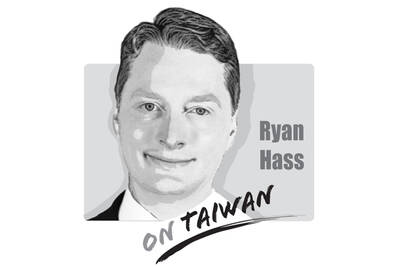A friend in China recently voiced concern over Taiwan’s recent disaster and said it was a pity tourists were unable to visit Alishan (阿里山). My friend then surprised me by saying they could instead view landslide dams caused by the flooding and suggested that Taiwan’s mountainous areas may have become a “land of a thousand lakes.”
I didn’t know how to react. President Ma Ying-jeou’s (馬英九) incompetence is now well known; but this was the first I had heard about landslide dams becoming a “tourist attraction.” Judging from the Post-Typhoon Morakot Reconstruction Special Act (莫拉克颱風災後重建特別條例) passed on Thursday, it seems Taiwan really could become covered in countless landslide dams.
The Act sets the limit for disaster relief and reconstruction at NT$120 billion (US$3.6 billion), but how will this money be allocated? No explanations are given. We only know that it will not be restricted by the Budget Act (預算法).
The Act also states that the money cannot be restricted by the Banking Act (銀行法), the Labor Standards Act (勞基法), the Employment Insurance Act (就業保險法), the Labor Pension Act (勞工退休金條例) or the National Property Act (國有財產法).
In addition, it ignores laws related to homeland security, including the Water Act (水利法), the Soil and Water Conservation Act (水土保持法), the Environmental Impact Assessment Act (環境影響評估法) and land regulation and forest protection acts.
Even worse, the Act includes no definition of disaster zones and victims, nor does it offer any explanation. This means that development and construction agencies will be able to expand the interpretation of these definitions. Inappropriate development is why the floods caused by Typhoon Morakot resulted in so many deaths in the first place.
The act will make it much easier to annul legal protection for disaster zones and allow projects like the relocation of villages, temporary shelters, roads, bridges and river dredging to bypass environmental assessments and deliberation procedures. It will thus open up mountainous and coastal areas so that the use of the NT$120 billion will become a force for creating countless landslide dams. The Act should rather be called a “sustainable disaster act.”
On the other hand, after last year’s earthquake in Sichuan, China adopted the Regulations on Post-Wenchuan Earthquake Rehabilitation and Reconstruction (汶川地震災後恢復重建條例) on June 4 last year. The regulations have 80 articles setting forth clear directions for the division of duties and responsibilities for the various stages of reconstruction work, including temporary shelter placement, investigations and assessments, recovery and reconstruction planning and implementation, fundraising, government assistance as well as monitoring and management.
The regulations were clearly and logically arranged and emphasized environmental protection, as well as demanding high standards of construction and prioritizing public safety.
Taiwan’s reconstruction act, on the other hand, does not include information on the various stages — like investigation and evaluation, planning and monitoring and management — nor does it make any demands for the upkeep of the environment, ecology or quality of construction.
It merely calls for things to be reconstructed.
Relief efforts have highlighted government incompetence, while reconstruction plans have exposed the ability of a bunch of savages to damage homeland security and how a group of greedy individuals are hoping to make exorbitant profits off of a national disaster.
Both of these groups are ensuring that Taiwan’s next disaster will be even worse.
Jay Fang is the chairman of the Green Consumers’ Foundation.
TRANSLATED BY DREW CAMERON

There has been much catastrophizing in Taiwan recently about America becoming more unreliable as a bulwark against Chinese pressure. Some of this has been sparked by debates in Washington about whether the United States should defend Taiwan in event of conflict. There also were understandable anxieties about whether President Trump would sacrifice Taiwan’s interests for a trade deal when he sat down with President Xi (習近平) in late October. On top of that, Taiwan’s opposition political leaders have sought to score political points by attacking the Lai (賴清德) administration for mishandling relations with the United States. Part of this budding anxiety
The diplomatic dispute between China and Japan over Japanese Prime Minister Sanae Takaichi’s comments in the Japanese Diet continues to escalate. In a letter to UN Secretary-General Antonio Guterres, China’s UN Ambassador Fu Cong (傅聰) wrote that, “if Japan dares to attempt an armed intervention in the cross-Strait situation, it would be an act of aggression.” There was no indication that Fu was aware of the irony implicit in the complaint. Until this point, Beijing had limited its remonstrations to diplomatic summonses and weaponization of economic levers, such as banning Japanese seafood imports, discouraging Chinese from traveling to Japan or issuing
On Nov. 8, newly elected Chinese Nationalist Party (KMT) Chairwoman Cheng Li-wun (鄭麗文) and Vice Chairman Chi Lin-len (季麟連) attended a memorial for White Terror era victims, during which convicted Chinese Communist Party (CCP) spies such as Wu Shi (吳石) were also honored. Cheng’s participation in the ceremony, which she said was part of her efforts to promote cross-strait reconciliation, has trapped herself and her party into the KMT’s dark past, and risks putting the party back on its old disastrous road. Wu, a lieutenant general who was the Ministry of National Defense’s deputy chief of the general staff, was recruited
The Food and Drug Administration (FDA) on Nov. 5 recalled more than 150,000 eggs found to contain three times the legal limit of the pesticide metabolite fipronil-sulfone. Nearly half of the 1,169 affected egg cartons, which had been distributed across 10 districts, had already been sold. Using the new traceability system, officials quickly urged the public to avoid consuming eggs with the traceability code “I47045,” while the remainder were successfully recalled. Changhua County’s Wenya Farm — the source of the tainted eggs — was fined NT$120,000, and the Ministry of Agriculture instructed the county’s Animal Disease Control Center to require that